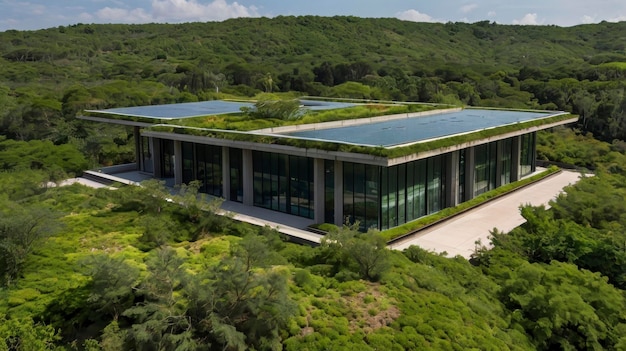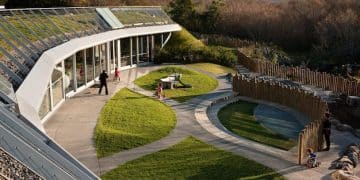Latest Green Building Materials Innovations in the US

The latest innovations in US green building materials for sustainable construction include bio-based materials like mycelium and bamboo, advanced insulation, green concrete alternatives, and smart technologies for energy efficiency.
Discover how the latest innovations in US green building materials for sustainable construction are transforming the industry. From eco-friendly alternatives to cutting-edge technologies, explore the future of building in the United States. Are you ready to build a greener tomorrow?
innovations in sustainable building materials
Sustainable building is rapidly evolving, driven by the need to reduce environmental impact and create healthier living spaces. The United States is at the forefront of this movement, with numerous companies and researchers developing innovative green building materials. These materials not only minimize carbon footprints but also enhance building performance and durability.
The focus on sustainability has led to the emergence of materials that are recycled, renewable, or produced with minimal environmental impact. These advancements are reshaping the construction industry, offering architects and builders more options for creating eco-friendly structures.
Bio-Based Materials
One of the most exciting areas of innovation is the development of bio-based materials. These materials are derived from renewable biological resources and offer a sustainable alternative to traditional building materials.
Bio-based materials are gaining traction due to their low carbon footprint and potential to sequester carbon. They also contribute to reducing waste and promoting a circular economy.
- Mycelium: Made from the root structure of mushrooms, mycelium can be molded into various shapes and used for insulation or structural components.
- Bamboo: A fast-growing, renewable resource, bamboo is used in flooring, walls, and even structural beams.
- Hempcrete: A mixture of hemp fibers, lime, and water, hempcrete is a lightweight, breathable material that provides excellent insulation.
Bio-based materials are not only eco-friendly but also offer unique performance characteristics, such as improved thermal insulation and sound absorption. As research and development continue, these materials are poised to play a significant role in sustainable construction.
In conclusion, bio-based materials represent a significant advancement in green building. Their renewable nature and low environmental impact make them a promising alternative to conventional materials, contributing to more sustainable and eco-friendly construction practices.

Advanced insulation materials
Effective insulation is crucial for reducing energy consumption in buildings. Traditional insulation materials like fiberglass and foam can have significant environmental impacts. Advanced insulation materials offer improved performance and sustainability.
The development of advanced insulation materials is driven by the need to reduce energy use and minimize the environmental impact of buildings. These materials often incorporate recycled content or utilize innovative manufacturing processes.
Aerogels
Aerogels are highly porous materials that offer exceptional thermal insulation. They are lightweight and can be used in various applications, including insulation panels and coatings.
Vacuum Insulation Panels (VIPs)
VIPs consist of a rigid core material encased in a gas-tight envelope. The vacuum inside the panel reduces heat transfer, providing superior insulation performance.
Advanced insulation materials not only improve energy efficiency but also contribute to healthier indoor environments. By reducing the need for heating and cooling, these materials help lower greenhouse gas emissions and create more comfortable living spaces.
- Recycled Denim Insulation: Made from recycled denim scraps, this insulation offers good thermal performance and diverts waste from landfills.
- Sheep’s Wool Insulation: A natural and renewable material, sheep’s wool provides excellent insulation and moisture control.
- Cellulose Insulation: Made from recycled paper, cellulose insulation is a cost-effective and environmentally friendly option.
Advanced insulation materials are transforming the building industry by providing more efficient and sustainable solutions for thermal management. These innovations are crucial for reducing energy consumption and creating greener buildings.
In summary, advanced insulation materials are essential for enhancing energy efficiency in buildings. Their innovative designs and sustainable compositions offer superior thermal performance and reduce environmental impact, contributing to a more sustainable built environment.
Green concrete alternatives
Concrete is one of the most widely used building materials, but its production is a major source of carbon emissions. Green concrete alternatives aim to reduce the environmental impact of concrete by using recycled materials and innovative production methods.
The environmental concerns associated with traditional concrete production have spurred the development of green alternatives. These alternatives not only reduce carbon emissions but also improve concrete’s durability and performance.
Recycled Aggregate Concrete
Recycled aggregate concrete uses crushed concrete or other recycled materials as a substitute for traditional aggregates. This reduces the demand for virgin materials and diverts waste from landfills.
Supplementary Cementitious Materials (SCMs)
SCMs, such as fly ash and slag, are byproducts of industrial processes that can be used to replace a portion of the cement in concrete. This reduces the carbon footprint of concrete and improves its durability.
Green concrete alternatives are gaining popularity as the construction industry seeks to reduce its environmental impact. These materials offer comparable or even superior performance compared to traditional concrete, while also contributing to a more sustainable built environment.
- Carbon-Capturing Concrete: This innovative concrete absorbs carbon dioxide from the atmosphere during its curing process, effectively sequestering carbon.
- Hempcrete: As mentioned earlier, hempcrete can also be used as a concrete alternative, providing a lightweight and sustainable option.
- Timbercrete: A composite material made from sawdust and cement, timbercrete offers a more sustainable alternative to traditional concrete blocks.
Green concrete alternatives are revolutionizing the construction industry by offering sustainable and high-performance solutions. These innovations are essential for reducing the environmental impact of concrete and creating a greener built environment.
In conclusion, green concrete alternatives offer a sustainable approach to reducing the environmental impact of construction. By using recycled materials and innovative production methods, these alternatives not only lower carbon emissions but also improve the durability and performance of concrete structures.

Smart building technologies
Smart building technologies are revolutionizing the way buildings are designed and operated. These technologies use sensors, data analytics, and automation to optimize energy use, improve indoor environmental quality, and enhance building performance.
The integration of smart technologies into buildings is driven by the need for greater efficiency and sustainability. These technologies enable real-time monitoring and control of building systems, leading to significant energy savings and improved occupant comfort.
Smart Lighting Systems
Smart lighting systems use sensors and controls to adjust lighting levels based on occupancy and daylight availability. This reduces energy consumption and creates more comfortable and productive environments.
Smart HVAC Systems
Smart HVAC systems use sensors and data analytics to optimize heating, ventilation, and air conditioning. This ensures that buildings are heated and cooled efficiently, reducing energy waste.
Smart building technologies are transforming the construction industry by providing greater control and efficiency. These technologies not only reduce energy consumption but also improve building performance and create more comfortable and sustainable environments.
- Building Automation Systems (BAS): BAS integrate various building systems, such as lighting, HVAC, and security, into a unified control platform.
- Energy Management Systems (EMS): EMS monitor and control energy consumption in buildings, providing real-time data and insights for optimization.
- Predictive Maintenance: Smart sensors and data analytics can be used to predict equipment failures and schedule maintenance proactively, reducing downtime and costs.
Smart building technologies are essential for creating sustainable and efficient buildings. By optimizing energy use and improving building performance, these innovations contribute to a greener and more comfortable built environment.
In summary, smart building technologies are critical for optimizing energy use and improving building performance. By integrating sensors, data analytics, and automation, these technologies create more efficient, comfortable, and sustainable environments.
Reducing construction waste
Construction waste is a significant environmental problem, with millions of tons of materials ending up in landfills each year. Reducing construction waste is essential for promoting sustainability and conserving resources.
The focus on waste reduction in the construction industry is driven by the need to minimize environmental impact and conserve resources. Implementing strategies to reduce, reuse, and recycle construction waste can lead to significant cost savings and environmental benefits.
Design for Disassembly
Designing buildings for disassembly involves using materials and construction methods that allow for easy deconstruction and reuse of building components. This reduces waste and extends the lifespan of building materials.
Material Salvage and Reuse
Salvaging and reusing building materials, such as wood, brick, and metal, can significantly reduce waste and conserve resources. These materials can be incorporated into new construction projects, giving them a new lease on life.
Reducing construction waste is a crucial aspect of sustainable building practices. By implementing strategies to minimize waste, reuse materials, and recycle construction debris, the industry can significantly reduce its environmental footprint.
- Recycling Programs: Implementing recycling programs on construction sites can divert waste from landfills and recover valuable materials.
- Waste Audits: Conducting waste audits can help identify sources of waste and develop strategies for reducing them.
- Modular Construction: Modular construction involves prefabricating building components off-site and assembling them on-site, reducing waste and construction time.
Reducing construction waste is essential for creating a more sustainable and resource-efficient construction industry. By implementing waste reduction strategies and promoting the reuse of materials, the industry can minimize its environmental impact and conserve valuable resources.
In conclusion, reducing construction waste is a fundamental aspect of sustainable building. By designing for disassembly, salvaging materials, and implementing recycling programs, the construction industry can significantly reduce its environmental footprint and conserve valuable resources.
Life cycle assessment (LCA)
Life Cycle Assessment (LCA) is a method for evaluating the environmental impacts of a product or building material throughout its entire life cycle, from raw material extraction to disposal. LCA helps identify opportunities for reducing environmental impacts and making more sustainable choices.
The use of LCA in the construction industry is growing as stakeholders seek to make more informed decisions about the environmental impacts of building materials and construction processes. LCA provides a comprehensive framework for assessing the environmental performance of buildings and identifying areas for improvement.
Cradle-to-Gate Assessment
Cradle-to-gate assessment evaluates the environmental impacts of a product or material from raw material extraction to the point of manufacture. This helps identify opportunities for reducing environmental impacts during the production process.
Cradle-to-Grave Assessment
Cradle-to-grave assessment evaluates the environmental impacts of a product or material throughout its entire life cycle, from raw material extraction to disposal or recycling. This provides a comprehensive view of the environmental performance of the material.
LCA is a valuable tool for promoting sustainability in the construction industry. By providing a comprehensive assessment of environmental impacts, LCA enables stakeholders to make more informed decisions and select materials and construction methods that minimize environmental harm.
- Environmental Product Declarations (EPDs): EPDs are standardized reports that provide information about the environmental impacts of a product or material based on LCA methodology.
- Building Information Modeling (BIM): BIM can be integrated with LCA tools to assess the environmental impacts of building designs and material choices.
- Sustainable Design Guidelines: LCA findings can inform sustainable design guidelines, helping architects and designers make more environmentally sound decisions.
LCA is essential for driving sustainability in the construction industry. By providing a comprehensive and transparent assessment of environmental impacts, LCA enables stakeholders to make more informed decisions and create more sustainable buildings.
In summary, Life Cycle Assessment (LCA) is a critical tool for evaluating the environmental impacts of building materials and construction processes. By providing a comprehensive assessment of environmental performance, LCA enables stakeholders to make more informed decisions and promote sustainability in the construction industry.
| Key Highlight | Brief Description |
|---|---|
| 🍄 Bio-Based Materials | Using mycelium and hempcrete reduces carbon footprint and waste in construction. |
| 💡 Advanced Insulation | Aerogels and VIPs increase energy efficiency with superior thermal performance. |
| ♻️ Green Concrete | Recycled aggregates and SCMs lower carbon emissions from concrete production. |
| 🌱 Waste Reduction | Designing for disassembly and material reuse minimizes construction waste. |
[Frequently Asked Questions]
▼
Bio-based building materials are derived from renewable biological resources like plants and fungi. Examples include mycelium, bamboo, and hempcrete.
▼
Advanced insulation materials such as aerogels and VIPs reduce energy consumption for heating and cooling, lowering greenhouse gas emissions.
▼
Green concrete alternatives reduce carbon emissions by using recycled materials and innovative production methods, promoting a more sustainable built environment.
▼
Smart building technologies optimize energy use through automation and real-time monitoring, enhancing building performance and reducing environmental impact.
▼
Reducing construction waste conserves resources and minimizes environmental impact by diverting materials from landfills and promoting material reuse.
Conclusion
The latest innovations in US green building materials for sustainable construction represent a significant step towards a more sustainable future. Embracing these materials and technologies can lead to buildings that are not only environmentally friendly but also healthier, more efficient, and more resilient. As awareness grows and technologies advance, the adoption of green building practices will continue to shape the construction industry for years to come.





